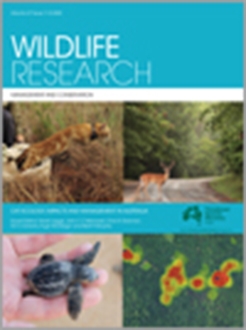Context. Wildlife detection dogs have been used globally in environmental monitoring. However, their effectiveness in the Australian context has been only minimally researched. Increased understanding of detection dog accuracy and efficacy is required for their inclusion in survey guidelines used by proponents of referred actions potentially impacting Australia’s threatened mammals. Evaluation of new methods is also important for advancing population monitoring, particularly for threatened species.
Aims. To determine the efficacy of wildlife detection dogs as a survey tool for low-density, cryptic species, using northern (Dasyurus hallucatus) and spotted-tailed (D. maculatus) quolls as subjects. We compared detection dogs, human search effort and camera trapping results, in simulated accuracy and efficacy trials, and field surveys.
Methods. Two wildlife detection dogs’ scores for sensitivity (ability to identify a target species scat) and specificity (ability to distinguish target from non-target species scats) were calculated during accuracy trials. The dogs were tested using 288 samples, of which 32 were targets, where northern and spotted-tailed quoll scat were the targets in separate trials. Survey efficacy was determined following completing 12 simulated surveys (6 per target species) involving a single, randomly placed scat sample in a 1–1.5 ha search area. During the northern quoll simulated surveys the dogs’ survey efficacy was compared with that of a human surveyor. The dogs also undertook field surveys for both northern and spotted-tailed quolls, in conjunction with camera trapping for comparison.
Key results. During accuracy trials the dogs had an average sensitivity and specificity respectively of 100% and 98.4% for northern quoll, and 100% and 98% for spotted-tailed quoll. Their average search time in efficacy trials for northern quoll was 11.07 min (significantly faster than the human surveyor), and 2.98 min for spotted-tailed quoll in the 1–1.5 ha search areas. During field surveys, northern quoll scats were detected at sites where camera trapping failed to determine their presence. No spotted-tailed quoll scat was detected by the dogs during field surveys.
Conclusions. Trained and experienced detection dogs can work very accurately and efficiently, which is vital to their field success. Detection dogs are therefore capable of detecting evidence of species presence where alternative methods may be unsuccessful.
Implications. Our study supports the future use of highly trained detection dogs for wildlife surveys and monitoring in Australia. Our results demonstrate that detection dogs can be highly accurate and are a beneficial stand-alone or complimentary method.






